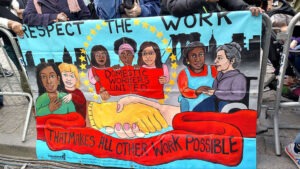
May 4, 2015; New York Times
Last week was an interesting one in the fight over minimum wage. On Monday the 4th, Fight for $15 announced that it would stage a protest at the McDonald’s corporate meeting coming up on May 21st because the workers they represent are “fed up with pay that drives them to rely on public assistance to support their families.” This movement for a higher minimum wage for fast food workers started gaining notice and momentum in late 2013.
On the same day, the New York Times reported on the fast-food giant’s just-announced reorganization plans. In a taped video message posted on McDonald’s corporate site, new CEO Steve Easterbrook told McDonald’s employees, “No business or brand has a divine right to succeed, and the reality is our recent performance has been poor. I will not shy away from the urgent need to reset this business.”
On Wednesday, May 6th, N.Y. Governor Andrew Cuomo announced that he was using his authority as governor to create a panel to make binding recommendations for a new minimum wage level in the fast food industry. In a New York Times Op-Ed column, Governor Cuomo noted:
“Nowhere is the income gap more extreme and obnoxious than in the fast-food industry. Fast-food C.E.O.s are among the highest-paid corporate executives. The average fast-food C.E.O. made $23.8 million in 2013, more than quadruple the average from 2000 (adjusting for inflation). Meanwhile, entry-level food-service workers in New York State earn, on average, $16,920 per year, which at a 40-hour week amounts to $8.50 an hour. Nationally, wages for fast-food workers have increased 0.3 percent since 2000 (again, adjusting for inflation).”
Sign up for our free newsletters
Subscribe to NPQ's newsletters to have our top stories delivered directly to your inbox.
By signing up, you agree to our privacy policy and terms of use, and to receive messages from NPQ and our partners.
“We are seeing the hollowing out of middle-wage jobs over time,” said Annette Bernhardt, a visiting researcher at UC Berkeley’s Institute for Research on Labor and Employment, who worked on a report on California employment trends that was released at the end of April. The study found despite being older and better educated, the “bottom 20 percent of workers have seen inflation-adjusted wages decline 12 percent since 1979.”
Earlier this year, McDonald’s tried to preempt the protests and the pressure by initiating its own plan to raise employee wages. Under the plan, the average McDonald’s employee will make $9.90 (an increase of one dollar) by July 2015 and $10 by 2016. Benefits like paid vacation time will be available for employees who have worked for the company for more than a year. However, although the plan will increase wages for the 90,000 workers who are directly employed by one of the company’s restaurants, the salaries of those 750,000 employees of McDonald’s franchisees were not affected by this decision. And as part of the recently announced reorganization plan, McDonald’s will be reducing the proportion of corporate-owned restaurants from the present level of around 20% to 10%, leaving an even greater number of workers outside the corporate pay program.
If one were concerned only about the interests of stockholders, raising wages in the face of declining sales and profits would seem unwise. Critics of increasing the minimum wage assert that it will actually harm both low-income workers and the businesses they work for. But the fact that low-wage workers rely on public supports like food stamps and Medicaid to provide for what is necessary but unaffordable at current salary levels changes the issue greatly. We are all affected by how profits are shared between shareholders and employees and have an interest in the best ways to solve the real-life problem of salaries not meeting the basic costs of survival.
McDonald’s provides an interesting case. Same-store sales at the 14,000-odd McDonald’s restaurants in the United States have fallen over the last five years. In the first quarter, revenues fell 11 percent from a year earlier to $5.96 billion. The battle over the minimum wage asks us to consider whether the current sharing of the benefits of profitability between workers, particularly low-income workers, and shareholders is right and fair. And it will ask managers to find solutions that are not based on keeping wages below a humane level.
If paying all workers a living wage means prices will have to increase, are we all willing to share that burden as consumers? Faced with this challenge, Seattle’s best-known chef, Tom Douglas, says he may have to close some of his 15 restaurants. But Douglas says it’s okay if higher prices force diners to cut back on eating out. He’d rather have people make a living wage instead of selling more chicken.—Marty Levine












